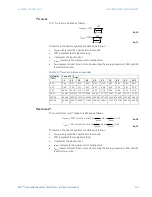
CHAPTER 7: PROTECTION
GROUPED PROTECTION ELEMENTS
D90
PLUS
LINE DISTANCE PROTECTION SYSTEM – INSTRUCTION MANUAL
221
the load impedance may enter into the relay characteristic for a time longer than the
chosen time delay, which could occur transiently during a system power swing. For this
reason the power swing blocking function should be used.
Phase distance zone 4 guidelines for the stepped distance scheme
As a further contribution to remote backup, the reach of this element must be set to
account for any infeed at the remote bus. The time delay must coordinate with other time-
delayed protection schemes on the next line. The use of a lens characteristic or the load
encroachment element may be advantageous if load limits are a problem.
To avoid extremely large reach settings, the D90
Plus
has the ability to implement any
element so that it is reverse looking. This can provide a back up for the longest line
terminated on the local bus. This strategy can be beneficial if the reduced reach helps
discrimination between the load and fault conditions, but it must be implemented at both
ends of the protected line.
Phase distance zone 5 guidelines for the stepped distance scheme
An additional fifth phase distance zone can be used in special applications. This zone may
be start zone for arming tripping from all other zones, in both forward and reverse
directions of the of protected line. This zone may also be used as an additional reverse-
looking zone for implementation of two reverse-looking zones, thus providing two zone
backup reverse-looking protection. The fifth distance zone can be used as an alarm zone,
indicating that load impedance is approaching the zone characteristic.
Ground distance neutral current supervision guidelines for the stepped distance
scheme
The current supervision for the ground distance elements responds to an internally
calculated neutral current (3 × I_0). The setting for this element should be based on twice
the zero-sequence line capacitance current or the maximum zero-sequence unbalance
under maximum load conditions. This element should not be used to prevent an output
when the load impedance is inside the distance characteristic on a steady-state basis.
Polarizing current and non-homogeneity correction angle of quadrilateral
characteristic for stepped distance scheme
An ideal reactance line for single-line-to-ground faults is polarized from the fault current
flowing through the fault resistance. Such a line defines constant reach and could be
implemented by the following angle comparator.
Eq. 8
The relay could only approximate the unknown fault current by the zero-sequence or the
negative-sequence currents measured at the relaying point. Depending on system
parameters, either the zero-sequence or the negative-sequence current presents better
approximation of the fault current angle.
)
,
M
9
=
,
î
²
î
YV





































